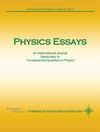zitterbeweung电子谜题
IF 0.5
Q4 PHYSICS, MULTIDISCIPLINARY
引用次数: 2
摘要
这项工作是对电子半经典描述的更新修订,包括H. J. Wilson基于原始狄拉克方程(DE)的完全相对论性QED-P模型。今后提出的模型超越了将电子描述为无结构的无维点状电荷的描述,其动量和位置由电子密度云描述的波函数的概率解释决定。这些模型具有共同的特征,提供有关电子性质的有用见解;例如,他们都认为ziterbewegung,一种光速的“沿途颤抖”电子运动,是一种真正的电子振荡运动。本文介绍的最后一个模型是Val Baker等人的电子质量模型。(理论物理。论文32,255(2019)],其中电子质量用全息面体积比Φ以及普朗克尺度下电荷与电子尺度下电荷的关系来定义,得到了与最新CODATA值一致的值。我们讨论了这些模型之间的关系。在我们看来,这些模型之间的大量对应不应该被轻视,这表明,这项研究提出了一些关于电子本质的非常基本的东西。本文章由计算机程序翻译,如有差异,请以英文原文为准。
The zitterbewegung electron puzzle
This work is an updated revision of semiclassical descriptions for the electron, including the fully relativistic QED-P model from H. J. Wilson based on the original Dirac equation (DE). The models presented hereafter go beyond the depiction of the electron as a structureless nondimensional point like charge with momentum and position determined by a probabilistic interpretation of the wavefunction described in terms of an electronic density cloud. These models share features in common that provide useful insights concerning the nature of the electron; for instance, they all consider zitterbewegung , a light speed “trembling-along-the-way” electron motion, to be a real oscillatory motion of the electron. The last model presented in this review is the electron mass model from Val Baker et al . [Phys. Essays 32 , 255 (2019)], where the electron mass is defined in terms of a holographic surface-to-volume ratio Φ and the relationship of the electric charge at the Planck scale to that at the electron scale, obtaining a value in agreement with the latest CODATA value. We discuss the relationship between these models. The large number of correspondences between the models should not be taken lightly and indicate, in our view, that something very fundamental about the nature of the electron is being put forward by this study.
求助全文
通过发布文献求助,成功后即可免费获取论文全文。
去求助
来源期刊

Physics Essays
PHYSICS, MULTIDISCIPLINARY-
自引率
83.30%
发文量
50
审稿时长
6-12 weeks
期刊介绍:
Physics Essays has been established as an international journal dedicated to theoretical and experimental aspects of fundamental problems in Physics and, generally, to the advancement of basic knowledge of Physics. The Journal’s mandate is to publish rigorous and methodological examinations of past, current, and advanced concepts, methods and results in physics research. Physics Essays dedicates itself to the publication of stimulating exploratory, and original papers in a variety of physics disciplines, such as spectroscopy, quantum mechanics, particle physics, electromagnetic theory, astrophysics, space physics, mathematical methods in physics, plasma physics, philosophical aspects of physics, chemical physics, and relativity.
 求助内容:
求助内容: 应助结果提醒方式:
应助结果提醒方式:


